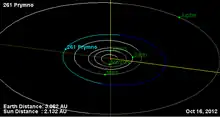 Orbital diagram | |
| Discovery | |
|---|---|
| Discovered by | C. H. F. Peters |
| Discovery date | 31 October 1886 |
| Designations | |
| (261) Prymno | |
| Pronunciation | /ˈprɪmnoʊ/ |
Named after | Prymno |
| A886 UA | |
| Main belt | |
| Adjectives | Prymnoian /prɪmˈnoʊ.iən/ |
| Orbital characteristics[1] | |
| Epoch 31 July 2016 (JD 2457600.5) | |
| Uncertainty parameter 0 | |
| Observation arc | 98.79 yr (36082 d) |
| Aphelion | 2.54054 AU (380.059 Gm) |
| Perihelion | 2.12336 AU (317.650 Gm) |
| 2.33195 AU (348.855 Gm) | |
| Eccentricity | 0.089449 |
| 3.56 yr (1300.7 d) | |
Average orbital speed | 19.51 km/s |
| 35.7611° | |
| 0° 16m 36.386s / day | |
| Inclination | 3.63567° |
| 96.6415° | |
| 65.9065° | |
| Physical characteristics | |
| Dimensions | 50.93±1.3 km |
| 8.002 h (0.3334 d) | |
| 0.1141±0.006 | |
| B | |
| 9.44 | |
Prymno (minor planet designation: 261 Prymno) is a somewhat large Main belt asteroid. It is classified as a B-type asteroid and probably has a primitive composition not unlike common C-type carbonaceous asteroids.
It was discovered by C. H. F. Peters on October 31, 1886, in Clinton, New York and was named after the Greek Oceanid Prymno.
References
- ↑ "261 Prymno". JPL Small-Body Database. NASA/Jet Propulsion Laboratory. Retrieved 11 May 2016.
External links
- Lightcurve plot of 261 Prymno, Palmer Divide Observatory, B. D. Warner (2009)
- Asteroid Lightcurve Database (LCDB), query form (info Archived 16 December 2017 at the Wayback Machine)
- Dictionary of Minor Planet Names, Google books
- Asteroids and comets rotation curves, CdR – Observatoire de Genève, Raoul Behrend
- Discovery Circumstances: Numbered Minor Planets (1)-(5000) – Minor Planet Center
- 261 Prymno at AstDyS-2, Asteroids—Dynamic Site
- 261 Prymno at the JPL Small-Body Database
This article is issued from Wikipedia. The text is licensed under Creative Commons - Attribution - Sharealike. Additional terms may apply for the media files.